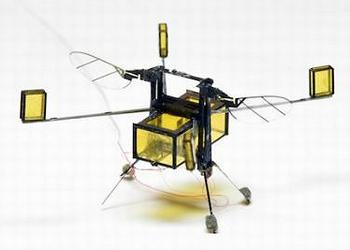
CAMBRIDGE, Massachusetts, February 19, 2019 (ENS) – Inspired by the biology of a bee, researchers at the Wyss Institute have developed RoboBees – constructed systems that can do tasks such as pollinating crops, going on search and rescue missions or conducting climate and environmental monitoring.
A RoboBee measures about half the size of a paper clip, weighs less than one-tenth of a gram, and flies using artificial muscles. The tiny robots flap their wings using piezoelectric actuators – strips of ceramic that expand and contract when an electric field is applied.

With submillimeter-scale anatomy and two wafer-thin wings that flap at 120 times per second, RoboBees can achieve vertical takeoff, hovering, and steering.
Thin hinges of plastic embedded within a carbon fiber body frame serve as joints, and a delicately balanced control system commands the rotational motions in the flapping-wing robot, with each wing controlled independently in real time.
Modifications allow some models of RoboBee to transition from swimming underwater to flying, and to perch on surfaces using static electricity.
The RoboBee was motivated by the need to develop autonomous micro-aerial vehicles capable of self-contained, self-directed flight and of achieving coordinated behavior in large groups. To that end, the RoboBee development is broadly divided into three main components: Body, Brain, and Colony.
Body development consists of constructing robotic insects able to fly on their own with the help of a compact and seamlessly integrated power source.
Brain development is concerned with “smart” sensors and control electronics that mimic the eyes and antennae of a bee, and can sense and respond dynamically to the environment.
The Colony’s focus is about coordinating the behavior of many independent robots so they act as an effective unit.
“It’s really only because of this lab’s recent breakthroughs in manufacturing, materials, and design that we have even been able to try this. And it just worked, spectacularly well,” said engineering professor Robert Wood, a founding core faculty member of the Wyss Institute for Biologically Inspired Engineering at Harvard.

To construct RoboBees, researchers at the Wyss Institute developed innovative manufacturing methods, so-called Pop-Up microelectromechanical, MEM, technologies that have already expanded the boundaries of robotics design and engineering.
This manufacturing technique, inspired by pop-up books and origami, allows the fabrication of microrobots and electromechanical devices for industrial and medical applications, says Wood.
Recent decades have seen rapid development in the manufacture of microelectromechanical systems, MEMS, at the micrometer scale, mostly based on silicon wafer processing techniques, with characteristic length scales of millimeters to nanometers Wood explains.
Then, drawing inspiration from laminated printed circuit board manufacturing, Wyss Institute researchers developed a bulk-machined Pop-Up MEMS process for creating mesoscale machines up to several centimeters in dimension.
Wood said, “Our new techniques allow us to use any material including polymers, metals, ceramics, and composites. Along with integrated electronics, this means that we can generate full systems in any three-dimensional shape.”
Pop-up MEMS could enable the production of smart, minimally invasive surgical instruments, novel implantable medical devices, specialized optical systems and a variety of electromechanical devices, including complex microrobots on the scale of micrometers to centimeters like the Wyss Institute’s RoboBees.
Wyss researchers are currently pursuing the creation of endoscope and surgical instrument steering mechanisms deploying this manufacturing process.
Copyright Environment News Service (ENS) 2019. All rights reserved.
